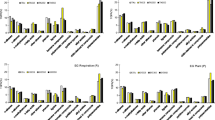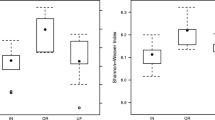Abstract
Soil organic carbon (SOC) turnover is the most ubiquitous and ecologically fundamental process in soils. It is generally assumed that SOC is utilised by functionally redundant soil-specific microbial communities which do not differ in their capability to mineralise soil organic matter. To challenge this assumption, incubation experiments were conducted to analyse the community-specific effects on SOC turnover for six mineral soils under different land-use. Comparisons of respiration by a native soil community and an alien community both inoculated to sterilised soils revealed 29 ± 18% higher respiration by the native community (‘home-field advantage’). Increased soil microbial community diversity, as generated by mixing several microbial inoculants, did not result in increased mineralisation rates. Even under impaired conditions, in the presence of aged engine oil as a less decomposable substance, communities with higher diversity did not show higher respiration rates. Also, in non-sterilised soils, we detected the influence of the microbial community composition on respiration rates: Investigations on the effect of mixing two communities in a 50:50 untreated soil mixture showed declining respiration in three out of six cases (by 23.9 ± 5.9%) and increased respiration in one case (by 57%) compared to the mean respiration of the two unmixed soils. These effects were highly related to the microbial community capability, with only communities with low capability profiting from mixing with a second community. Our results question the assumption of redundancy of microbial community’s functionality for SOC mineralisation in soils.






Similar content being viewed by others
References
Adair EC, Parton WJ, Del Grosso SJ, Silver WL, Harmon ME, Hall SA, Burke IC, Hart SC (2008) Simple three-pool model accurately describes patterns of long-term litter decomposition in diverse climates. Glob Chang Biol 14:2636–2660. doi:10.1111/j.1365-2486.2008.01674.x
Anderson JPE, Domsch KH (1978) Physiological methods for quantitative measurements of microbial biomass in soils. Soil Biol Biochem 10:215–221. doi:10.1016/0038-0717(78)90099-8
Atlas RM (1995) Bioremediation of petroleum pollutants. Biodter Biodegrad 35:317–327. doi:10.1016/0964-8305(95)00030-9
Ayres E, Steltzer H, Simmons BL, Simpson RT, Steinweg JM, Wallenstein MD, Mellor N, Parton WJ, Moore JC, Wall DH (2009) Home-field advantage accelerates leaf litter decomposition in forests. Soil Biol Biochem 41:606–610. doi:10.1016/j.soilbio.2008.12.022
Bento FM, Camargo FAO, Okeke BC, Frankenberger WT (2005) Comparative bioremediation of soils contaminated with diesel oil by natural attenuation, biostimulation and bioaugmentation. Bioresour Technol 96:1049–1055. doi:10.1016/j.biotech.2004.09.008
Berns AE, Philipp H, Narres HD, Burauel P, Vereecken H, Tappe W (2008) Effect of gamma-sterilization and autoclaving on soil organic matter structure as studied by solid state NMR, UV and fluorescence spectroscopy. Europ J Soil Sci 59:540–550. doi:10.1111/j.1365-2389.2008.01016.x
Blagodatskaya EV, Anderson T-H (1998) Interactive effects of pH and substrate quality on the fungal-to-bacterial ratio and qCO2 of microbial communities in forest soils. Soil Biol Biochem 30:1269–1274. doi:10.1016/S0038-0717(98)00050-9
Blanchet M, Pringault O, Bouvy M, Catala P, Oriol L, Caparros J, Ortega-Retuerta E, Intertaglia L, West N, Agis M, Got P, Joux F (2015) Changes in bacterial community metabolism and composition during the degradation of dissolved organic matter from the jellyfish Aurelia aurita in a Mediterranean coastal lagoon. Environ Sci Pollution Res 22:13638–13653. doi:10.1007/s11356-014-3848-x
Boeddinghaus RS, Nunan N, Berner D, Marhan S, Kandeler E (2015) Do general spatial relationships for microbial biomass and soil enzyme activities exist in temperate grassland soils? Soil Biol Biochem 88:430–440. doi:10.1016/j.soilbio.2015.05.026
Castro H, Barrico L, Rodriguez-Echeverria S, Freitas H (2016) Trends in plant and soil microbial diversity associated with Mediterranean extensive cereal-fallow rotation agro-ecosystems. Agricult Ecosyst Environ 217:33–40. doi:10.1016/j.agee.2015.10.027
Delmont TO, Eren AM, Maccario L, Prestat E, Esen ÖC, Pelletier E, Le Paslier D, Simonet P, Vogel TM (2014) Microbial community development and unseen diversity recovery in inoculated sterile soil. Biol Fertil Soils 50:1069–1076. doi:10.1007/s00374-014-0925-8
Dohrmann AB, Walz M, Lowen A, Tebbe CC (2015) Clostridium cluster I and their pathogenic members in a full-scale operating biogas plant. Appl Microbiol Biotechnology 99:3585–3598. doi:10.1007/s00253-014-6261-y
Fargione J, Tilman D, Dybzinski R, HilleRisLambers J, Clark C, Harpole WS, Knops JMH, Reich PB, Loreau M (2007) From selection to complementarity: shifts in the causes of biodiversity-productivity relationships in a long-term biodiversity experiment. Proceedings Royal Society B-Biological Sciences 274:871–876. doi:10.1098/rspb.2006.0351
Franzluebbers AJ, Haney RL, Hons FM, Zuberer DA (1996) Active fractions of organic matter in soils with different texture. Soil Biol Biochem 28:1367–1372. doi:10.1016/S0038-0717(96)00143-5
Freschet GT, Aerts R, Cornelissen JHC (2012) Multiple mechanisms for trait effects on litter decomposition: moving beyond home-field advantage with a new hypothesis. J Ecol 100:619–630. doi:10.1111/j.1365-2745.2011.01943.x
Fuhrman JA (2009) Microbial community structure and its functional implications. Nature 459:193–199
Fyles JW, Fyles IH (1993) Interaction of Douglas-fir with red alder and salal foliage litter during decomposition. Canadian J Forest Res 23:358–361. doi:10.1139/x93-052
Giesselmann UC, Martins KG, Brandle M, Schadler M, Marques R, Brandi R (2011) Lack of home-field advantage in the decomposition of leaf litter in the Atlantic rainforest of Brazil. Appl Soil Ecol 49:5–10. doi:10.1016/j.apsoil.2011.07.010
Graham EB, Knelman JE, Schindlbacher A, Siciliano S, Breulmann M, Yannarell A, Beman JM, Abell G, Philippot L, Prosser J, Foulquier A, Yuste JC, Glanville HC, Jones DL, Angel R, Salminen J, Newton RJ, Bürgmann H, Ingram LJ, Hamer U, Siljanen HMP, Peltoniemi K, Potthast K, Bañeras L, Hartmann M, Banerjee S, Yu R-Q, Nogaro G, Richter A, Koranda M, Castle SC, Goberna M, Song B, Chatterjee A, Nunes OC, Lopes AR, Cao Y, Kaisermann A, Hallin S, Strickland MS, Garcia-Pausas J, Barba J, Kang H, Isobe K, Papaspyrou S, Pastorelli R, Lagomarsino A, Lindström ES, Basiliko N, Nemergut DR (2016) Microbes as engines of ecosystem function: when does community structure enhance predictions of ecosystem processes? Front Microbiol 7:214–222
Griffiths BS, Ritz K, Wheatley R, Kuan HL, Boag B, Christensen S, Ekelund F, Sørensen SJ, Muller S, Bloem J (2001) An examination of the biodiversity-ecosystem function relationship in arable soil microbial communities. Soil Biol Biochem 33:1713–1722. doi:10.1016/s0038-0717(01)00094-3
He SL, Niu QG, Li YY, Nie YL, Hou MF (2015) Factors associated with the diversification of the microbial communities within different natural and artificial saline environments. Ecol Engineering 83:476–484. doi:10.1016/j.ecoleng.2015.06.029
Heinemeyer O, Insam H, Kaiser EA, Walenzik G (1989) Soil microbial biomass and respiration measurements—an automated technique based on infrared gas-analysis. Plant Soil 116:191–195. doi:10.1007/bf02214547
Jaillard B, Rapaport A, Harmand J, Brauman A, Nunan N (2014) Community assembly effects shape the biodiversity-ecosystem functioning relationships. Funct Ecol 28:1523–1533. doi:10.1111/1365-2435.12267
Juarez S, Nunan N, Duday A-C, Pouteau V, Chenu C (2013) Soil carbon mineralisation responses to alterations of microbial diversity and soil structure. Biol Fertil Soils 49:939–948. doi:10.1007/s00374-013-0784-8
Kaiser EA, Mueller T, Joergensen RG, Insam H, Heinemeyer O (1992) Evaluation of methods to estimate the soil microbial biomass and the relationship with soil texture and organic matter. Soil Biol Biochem 24:675–683. doi:10.1016/0038-0717(92)90046-z
Keiser AD, Keiser DA, Strickland MS, Bradford MA (2014) Disentangling the mechanisms underlying functional differences among decomposer communities. J Ecol 102:603–609. doi:10.1111/1365-2745.12220
Knelman JE, Graham EB, Trahan NA, Schmidt SK, Nemergut DR (2015) Fire severity shapes plant colonization effects on bacterial community structure, microbial biomass, and soil enzyme activity in secondary succession of a burned forest. Soil BiolBiochem 90:161–168. doi:10.1016/j.soilbio.2015.08.004
Levine UY, Teal TK, Robertson GP, Schmidt TM (2011) Agriculture’s impact on microbial diversity and associated fluxes of carbon dioxide and methane. Isme J 5:1683–1691. doi:10.1038/ismej.2011.40
Loreau M (2010) Linking biodiversity and ecosystems: towards a unifying ecological theory. Philos T Roy Soc B 365:49–60. doi:10.1098/rstb.2009.0155
Lützow von M, Kögel-Knabner I, Ekschmitt K, Matzner E, Guggenberger G, Marschner B, Flessa H (2006) Stabilization of organic matter in temperate soils: mechanisms and their relevance under different soil conditions—a review. Europ J of Soil Sci 57:426–445. doi:10.1111/j.1365-2389.2006.00809.x
McNamara NP, Black HIJ, Beresford NA, Parekh NR (2003) Effects of acute gamma irradiation on chemical, physical and biological properties of soils. Appl Soil Ecol 24:117–132. doi:10.1016/s0929-1393(03)00073-8
McTiernan KB, Ineson P, Coward PA (1997) Respiration and nutrient release from tree leaf litter mixtures. Oikos 78:527–538. doi:10.2307/3545614
Mendes LW, Brossi MJD, Kuramae EE, Tsai SM (2015) Land-use system shapes soil bacterial communities in southeastern Amazon region. Appl Soil Ecol 95:151–160. doi:10.1016/j.apsoil.2015.06.005
Nannipieri P, Ascher J, Ceccherini MT, Landi L, Pietramellara G, Renella G (2003) Microbial diversity and soil functions. Europ J Soil Sci 54:655–670. doi:10.1046/j.1351-0754.2003.0556.x
Nielsen UN, Ayres E, Wall DH, Bardgett RD (2011) Soil biodiversity and carbon cycling: a review and synthesis of studies examining diversity-function relationships. Europ J Soil Sci 62:105–116. doi:10.1111/j.1365-2389.2010.01314.x
Omotayo AE, Ojo OY, Amund OO (2012) Crude oil degradation by microorganisms in soil composts. Res J Microbiol 7:209–218. doi:10.3923/jm.2012.209.218
Poeplau C, Don A (2013) Sensitivity of soil organic carbon stocks and fractions to different land-use changes across Europe. Geoderma 192:189–201. doi:10.1016/j.geoderma.2012.08.003
Prescott CE, Grayston SJ (2013) Tree species influence on microbial communities in litter and soil: current knowledge and research needs. Forest Ecol Manag 309:19–27. doi:10.1016/j.foreco.2013.02.034
R-Core-Team (2015) R: A language and environment for statistical computing. R Foundation for Statistical Computing, Vienna. URL http://www.R-project.org/.
Rillig MC, Antonovics J, Caruso T, Lehmann A, Powell JR, Veresoglou SD, Verbruggen E (2015) Interchange of entire communities: microbial community coalescence. Trends Ecol Evolution 30:470–476. doi:10.1016/j.tree.2015.06.004
Salomons W, Stigliani W (2012) Biogeodynamics of pollutants in soils and sediments: risk assessment of delayed and non-linear responses. Springer, Berlin Heidelberg
Schimel JP, Schaeffer SM (2012) Microbial control over carbon cycling in soil. Frontiers Microbiol 3:11. doi:10.3389/fmicb.2012.00348
Schloss PD, Westcott SL, Ryabin T, Hall JR, Hartmann M, Hollister EB, Lesniewski RA, Oakley BB, Parks DH, Robinson CJ, Sahl JW, Stres B, Thallinger GG, Van Horn DV, Weber CF (2009) Introducing mothur: open-source, platform-independent, community-supported software for describing and comparing microbial communities. Appl Environ Microbiol 75:7537–7541. doi:10.1128/aem.01541-09
Shaw LJ, Beaton Y, Glover LA, Killham K, Meharg AA (1999) Re-inoculation of autoclaved soil as a non-sterile treatment for xenobiotic sorption and biodegradation studies. Appl Soil Ecol 11:217–226. doi:10.1016/s0929-1393(98)00149-8
Skipper HD, Westermann DT (1973) Comparative effects of propylene oxide sodium azide and autoclaving on selected soil properties. Soil Biol Biochem 5:409–414. doi:10.1016/0038-0717(73)90067-9
St. John MG, Orwin KH, Dickie IA (2011) No ‘home’ versus ‘away’ effects of decomposition found in a grassland-forest reciprocal litter transplant study. Soil Biol Biochem 43:1482–1489
Strickland MS, Lauber C, Fierer N, Bradford MA (2009) Testing the functional significance of microbial community composition. Ecology 90:441–451. doi:10.1890/08-0296.1
Trabelsi D, Mhamdi R (2013) Microbial inoculants and their impact on soil microbial communities: a review. Biomed Res Int :11. doi:10.1155/2013/863240
Turnbull LA, Levine JM, Loreau M, Hector A (2013) Coexistence, niches and biodiversity effects on ecosystem functioning. Ecol Lett 16:116–127. doi:10.1111/ele.12056
Wagg C, Bender SF, Widmer F, van der Heijden MGA (2014) Soil biodiversity and soil community composition determine ecosystem multifunctionality. P Natl Acad Sci USA 111:5266–5270. doi:10.1073/pnas.1320054111
Wertz S, Degrange V, Prosser JI, Poly F, Commeaux C, Freitag T, Guillaumaud N, Roux XL (2006) Maintenance of soil functioning following erosion of microbial diversity. Environ Microbiol 8:2162–2169. doi:10.1111/j.1462-2920.2006.01098.x
Xun W, Huang T, Zhao J, Ran W, Wang B, Shen Q, Zhang R (2015) Environmental conditions rather than microbial inoculum composition determine the bacterial composition, microbial biomass and enzymatic activity of reconstructed soil microbial communities. Soil Biol Biochem 90:10–18. doi:10.1016/j.soilbio.2015.07.018
Zhou X, Zhang Y, Downing A (2012) Non-linear response of microbial activity across a gradient of nitrogen addition to a soil from the Gurbantunggut Desert, northwestern China. Soil Biol Biochem 47:67–77. doi:10.1016/j.soilbio.2011.05.012
Zimmermann M, Leifeld J, Schmidt MWI, Smith P, Fuhrer J (2007) Measured soil organic matter fractions can be related to pools in the RothC model. Europ J Soil Sci 58:658–667. doi:10.1111/j.1365-2389.2006.00855.x
Acknowledgements
We thank Claudia Wiese for DNA characterisation of the samples. Lena Rohe and Susanne Behn have our thanks for their dedicated help regarding soil sterilisation. For fruitful discussion, we also thank Kim Milferstedt. This work was funded by the FP7 project GHG-Europe project; grant no. 244122 and the Federal Ministry of Education and Research funded project BonRes Sustainable Subsoil Management SOIL3.
Author information
Authors and Affiliations
Corresponding author
Rights and permissions
About this article
Cite this article
Don, A., Böhme, I.H., Dohrmann, A.B. et al. Microbial community composition affects soil organic carbon turnover in mineral soils. Biol Fertil Soils 53, 445–456 (2017). https://doi.org/10.1007/s00374-017-1198-9
Received:
Revised:
Accepted:
Published:
Issue Date:
DOI: https://doi.org/10.1007/s00374-017-1198-9




